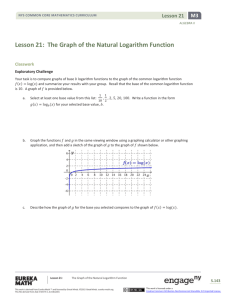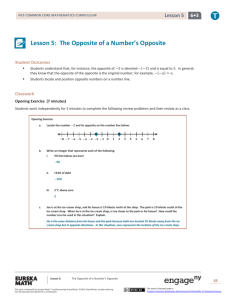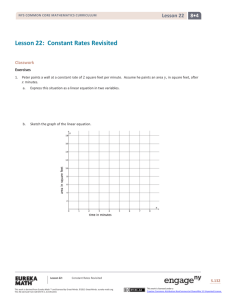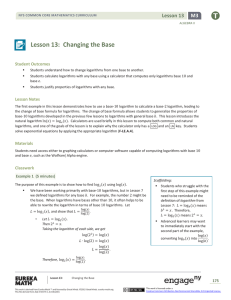Algebra II Module 3, Topic B, Lesson 13: Student Version
advertisement
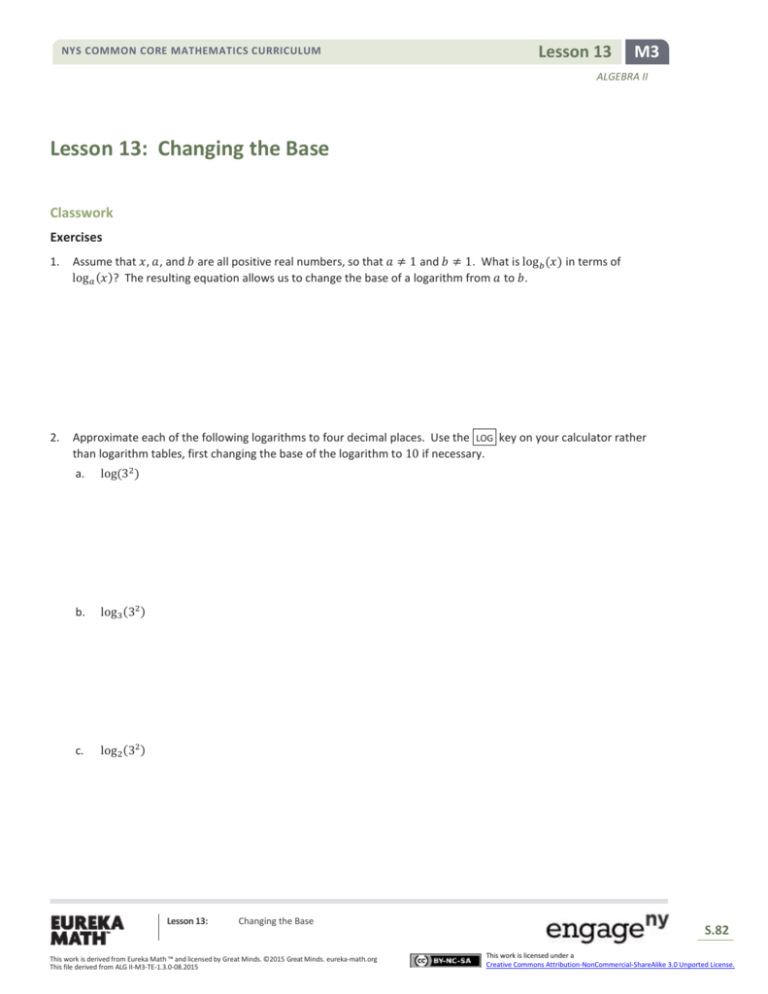
NYS COMMON CORE MATHEMATICS CURRICULUM Lesson 13 M3 ALGEBRA II Lesson 13: Changing the Base Classwork Exercises 1. Assume that 𝑥, 𝑎, and 𝑏 are all positive real numbers, so that 𝑎 ≠ 1 and 𝑏 ≠ 1. What is log 𝑏 (𝑥) in terms of log 𝑎 (𝑥)? The resulting equation allows us to change the base of a logarithm from 𝑎 to 𝑏. 2. Approximate each of the following logarithms to four decimal places. Use the LOG key on your calculator rather than logarithm tables, first changing the base of the logarithm to 10 if necessary. a. log(32 ) b. log 3 (32 ) c. log 2 (32 ) Lesson 13: Changing the Base This work is derived from Eureka Math ™ and licensed by Great Minds. ©2015 Great Minds. eureka-math.org This file derived from ALG II-M3-TE-1.3.0-08.2015 S.82 This work is licensed under a Creative Commons Attribution-NonCommercial-ShareAlike 3.0 Unported License. NYS COMMON CORE MATHEMATICS CURRICULUM Lesson 13 M3 ALGEBRA II 3. In Lesson 12, we justified a number of properties of base-10 logarithms. Working in pairs, justify the following properties of base 𝑏 logarithms: a. log 𝑏 (1) = 0 b. log 𝑏 (𝑏) = 1 c. log 𝑏 (b𝑟 ) = 𝑟 d. 𝑏 log𝑏 (𝑥) = 𝑥 e. log 𝑏 (𝑥 ∙ 𝑦) = log 𝑏 (𝑥) + log 𝑏 (𝑦) Lesson 13: Changing the Base This work is derived from Eureka Math ™ and licensed by Great Minds. ©2015 Great Minds. eureka-math.org This file derived from ALG II-M3-TE-1.3.0-08.2015 S.83 This work is licensed under a Creative Commons Attribution-NonCommercial-ShareAlike 3.0 Unported License. NYS COMMON CORE MATHEMATICS CURRICULUM Lesson 13 M3 ALGEBRA II 4. 5. f. log 𝑏 (𝑥 𝑟 ) = 𝑟 ∙ log 𝑏 (𝑥) g. log 𝑏 ( ) = −log 𝑏 (𝑥) h. log 𝑏 ( ) = log 𝑏 (𝑥) − log 𝑏 (𝑦) 1 𝑥 𝑥 𝑦 Use the LN and LOG keys on your calculator to find the value of each logarithm to four decimal places. a. ln(1) log(1) b. ln(3) log(3) c. ln(10) log(10) d. ln(25) log(25) e. ln(100) log(100) Make a conjecture that compares values of log(𝑥) to ln(𝑥) for 𝑥 ≥ 1. Lesson 13: Changing the Base This work is derived from Eureka Math ™ and licensed by Great Minds. ©2015 Great Minds. eureka-math.org This file derived from ALG II-M3-TE-1.3.0-08.2015 S.84 This work is licensed under a Creative Commons Attribution-NonCommercial-ShareAlike 3.0 Unported License. Lesson 13 NYS COMMON CORE MATHEMATICS CURRICULUM M3 ALGEBRA II 6. Justify your conjecture in Exercise 5 using the change of base formula. 7. Write as a single logarithm. 8. 1 3 a. ln(4) − 3ln ( ) + ln(2) b. ln(5) + ln(32) − ln(4) 3 5 Write each expression as a sum or difference of constants and logarithms of simpler terms. a. ln ( b. ln ( √5𝑥3 𝑒2 ) (𝑥 + 𝑦)2 𝑥2 + 𝑦2 ) Lesson 13: Changing the Base This work is derived from Eureka Math ™ and licensed by Great Minds. ©2015 Great Minds. eureka-math.org This file derived from ALG II-M3-TE-1.3.0-08.2015 S.85 This work is licensed under a Creative Commons Attribution-NonCommercial-ShareAlike 3.0 Unported License. Lesson 13 NYS COMMON CORE MATHEMATICS CURRICULUM M3 ALGEBRA II Lesson Summary We have established a formula for changing the base of logarithms from 𝑏 to 𝑎: log 𝑏 (𝑥) = log 𝑎 (𝑥) . log 𝑎 (𝑏) In particular, the formula allows us to change logarithms base 𝑏 to common or natural logarithms, which are the only two kinds of logarithms that most calculators compute: log b (𝑥) = log(𝑥) ln(𝑥) = . log(𝑏) ln(𝑏) We have also established the following properties for base 𝑏 logarithms. If 𝑥, 𝑦, 𝑎, and 𝑏 are all positive real numbers with 𝑎 ≠ 1 and 𝑏 ≠ 1 and 𝑟 is any real number, then: 1. log 𝑏 (1) = 0 2. log 𝑏 (𝑏) = 1 3. log 𝑏 (𝑏 𝑟 ) = 𝑟 4. 𝑏 log𝑏 (𝑥) = 𝑥 5. log 𝑏 (𝑥 ∙ 𝑦) = log 𝑏 (𝑥) + log 𝑏 (𝑦) 6. log 𝑏 (𝑥 𝑟 ) = 𝑟 ∙ log 𝑏 (𝑥) 7. log 𝑏 ( ) = −log 𝑏 (𝑥) 8. 1 𝑥 𝑥 log 𝑏 ( ) = log 𝑏 (𝑥) − log 𝑏 (𝑦) 𝑦 Problem Set 1. Evaluate each of the following logarithmic expressions, approximating to four decimal places if necessary. Use the LN or LOG key on your calculator rather than a table. b. log 8 (16) log 7 (11) c. log 3 (2) + log 2 (3) a. 2. Use logarithmic properties and the fact that ln(2) ≈ 0.69 and ln(3) ≈ 1.10 to approximate the value of each of the following logarithmic expressions. Do not use a calculator. a. ln(𝑒 4 ) b. ln(6) c. ln(108) d. ln ( ) 8 3 Lesson 13: Changing the Base This work is derived from Eureka Math ™ and licensed by Great Minds. ©2015 Great Minds. eureka-math.org This file derived from ALG II-M3-TE-1.3.0-08.2015 S.86 This work is licensed under a Creative Commons Attribution-NonCommercial-ShareAlike 3.0 Unported License. Lesson 13 NYS COMMON CORE MATHEMATICS CURRICULUM M3 ALGEBRA II 3. Compare the values of log 1 (10) and log 9 ( 9 1 ) without using a calculator. 10 4. Show that for any positive numbers 𝑎 and 𝑏 with 𝑎 ≠ 1 and 𝑏 ≠ 1, log 𝑎 (𝑏) ∙ log 𝑏 (𝑎) = 1. 5. Express 𝑥 in terms of 𝑎, 𝑒, and 𝑦 if ln(𝑥) − ln(𝑦) = 2𝑎. 6. Rewrite each expression in an equivalent form that only contains one base 10 logarithm. 7. 8. a. log 2 (800) b. log 𝑥 ( c. log 5 (12500) d. log 3 (0.81) Write each number in terms of natural logarithms, and then use the properties of logarithms to show that it is a rational number. a. log 9 (√27) b. log 8 (32) c. log 4 ( ) 1 8 Write each expression as an equivalent expression with a single logarithm. Assume 𝑥, 𝑦, and 𝑧 are positive real numbers. a. b. c. 9. 1 ), for positive real values of 𝑥 ≠ 1 10 ln(𝑥) + 2 ln(𝑦) − 3 ln(𝑧) 1 2 (ln(𝑥 + 𝑦) − ln(𝑧)) (𝑥 + 𝑦) + ln(𝑧) Rewrite each expression as sums and differences in terms of ln(𝑥), ln(𝑦), and ln(𝑧). a. ln(𝑥𝑦𝑧 3 ) b. ln ( c. ln (√ ) 𝑒3 ) 𝑥𝑦𝑧 𝑥 𝑦 Lesson 13: Changing the Base This work is derived from Eureka Math ™ and licensed by Great Minds. ©2015 Great Minds. eureka-math.org This file derived from ALG II-M3-TE-1.3.0-08.2015 S.87 This work is licensed under a Creative Commons Attribution-NonCommercial-ShareAlike 3.0 Unported License. Lesson 13 NYS COMMON CORE MATHEMATICS CURRICULUM M3 ALGEBRA II 10. Use base-5 logarithms to rewrite each exponential equation as a logarithmic equation, and solve the resulting equation. Use the change of base formula to convert to a base-10 logarithm that can be evaluated on a calculator. Give each answer to 4 decimal places. If an equation has no solution, explain why. a. 52𝑥 = 20 b. 75 = 10 ∙ 5𝑥−1 c. 52+𝑥 − 5𝑥 = 10 d. 5𝑥 = 0.25 2 11. In Lesson 6, you discovered that log(𝑥 ∙ 10𝑘 ) = 𝑘 + log(𝑥) by looking at a table of logarithms. Use the properties of logarithms to justify this property for an arbitrary base 𝑏 > 0 with 𝑏 ≠ 1. That is, show that log 𝑏 (𝑥 ∙ 𝑏 𝑘 ) = 𝑘 + log 𝑏 (𝑥). 12. Larissa argued that since log 2 (2) = 1 and log 2 (4) = 2, then it must be true that log 2 (3) = 1.5. Is she correct? Explain how you know. 13. Extension: Suppose that there is some positive number 𝑏 so that log 𝑏 (2) = 0.36 log 𝑏 (3) = 0.57 log 𝑏 (5) = 0.84. a. b. Use the given values of log 𝑏 (2), log 𝑏 (3), and log 𝑏 (5) to evaluate the following logarithms: i. log 𝑏 (6) ii. log 𝑏 (8) iii. log 𝑏 (10) iv. log 𝑏 (600) Use the change of base formula to convert log 𝑏 (10) to base 10, and solve for 𝑏. Give your answer to four decimal places. 14. Use a logarithm with an appropriate base to solve the following exponential equations. a. 23𝑥 = 16 b. 2𝑥+3 = 43𝑥 c. 34𝑥−2 = 27𝑥+2 d. 42𝑥 = ( ) e. 50.2𝑥+3 = 625 1 4 3𝑥 Lesson 13: Changing the Base This work is derived from Eureka Math ™ and licensed by Great Minds. ©2015 Great Minds. eureka-math.org This file derived from ALG II-M3-TE-1.3.0-08.2015 S.88 This work is licensed under a Creative Commons Attribution-NonCommercial-ShareAlike 3.0 Unported License. NYS COMMON CORE MATHEMATICS CURRICULUM Lesson 13 M3 ALGEBRA II 15. Solve each exponential equation. a. 32𝑥 = 81 3𝑥 h. 2𝑥 = 81 i. 8 = 3𝑥 b. 6 c. 625 = 53𝑥 j. 6𝑥+2 = 12 d. 254−𝑥 = 53𝑥 k. 10𝑥+4 = 27 e. 32𝑥−1 = l. 2𝑥+1 = 31−𝑥 f. g. = 36 𝑥+1 42𝑥 2𝑥−3 1 1 2 m. 32𝑥−3 = 2𝑥+4 =1 82𝑥−4 =1 n. 𝑒 2𝑥 = 5 o. 𝑒 𝑥−1 = 6 16. In Problem 9(e) of Lesson 12, you solved the equation 3𝑥 = 7−3𝑥+2 using the logarithm base 10. a. Solve 3𝑥 = 7−3𝑥+2 using the logarithm base 3. b. Apply the change of base formula to show that your answer to part (a) agrees with your answer to Problem 9(e) of Lesson 12. c. Solve 3𝑥 = 7−3𝑥+2 using the logarithm base 7. d. Apply the change of base formula to show that your answer to part (c) also agrees with your answer to Problem 9(e) of Lesson 12. 17. Pearl solved the equation 2𝑥 = 10 as follows: log(2𝑥 ) = log(10) 𝑥 log(2) = 1 𝑥= 1 . log(2) Jess solved the equation 2𝑥 = 10 as follows: log 2 (2𝑥 ) = log 2 (10) 𝑥 log 2 (2) = log 2 (10) 𝑥 = log 2 (10). Is Pearl correct? Is Jess correct? Explain how you know. Lesson 13: Changing the Base This work is derived from Eureka Math ™ and licensed by Great Minds. ©2015 Great Minds. eureka-math.org This file derived from ALG II-M3-TE-1.3.0-08.2015 S.89 This work is licensed under a Creative Commons Attribution-NonCommercial-ShareAlike 3.0 Unported License.






